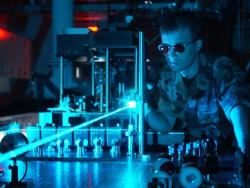
Society
Main Category
Sub Category
Era
Date Created
Location Country
us
Coordinates
40.685764, -74.403151
Address1
600-700 Mountain Avenue
City
Murray Hill
State
Country
Zip
Website
Creator
As ideas developed, they abandoned infrared radiation to instead concentrate upon visible light. The concept originally was called an "optical maser". In 1958, Bell Labs filed a patent application for their proposed optical maser; and Schawlow and Townes submitted a manuscript of their theoretical calculations to the Physical Review, published that year in Volume 112, Issue No. 6.
Simultaneously, at Columbia University, graduate student Gordon Gould was working on a doctoral thesis about the energy levels of excited thallium. When Gould and Townes met, they spoke of radiation emission, as a general subject; afterwards, in November 1957, Gould noted his ideas for a “laser”, including using an open resonator (later an essential laser-device component).
Moreover, in 1958, Prokhorov independently proposed using an open resonator, the first published appearance (the USSR) of this idea. Elsewhere, in the U.S., Schawlow and Townes had agreed to an open-resonator laser design – apparently unaware of Prokhorov’s publications and Gould’s unpublished laser work.
At a conference in 1959, Gordon Gould published the term LASER in the paper The LASER, Light Amplification by Stimulated Emission of Radiation.
Gould’s notes included possible applications for a laser, such as spectrometry, interferometry, radar, and nuclear fusion. He continued developing the idea, and filed a patent application in April 1959. The U.S. Patent Office denied his application, and awarded a patent to Bell Labs, in 1960. That provoked a twenty-eight-year lawsuit, featuring scientific prestige and money as the stakes.
Gould won his first minor patent in 1977, yet it was not until 1987 that he won the first significant patent lawsuit victory, when a Federal judge ordered the U.S. Patent Office to issue patents to Gould for the optically pumped and the gas discharge laser devices. The question of just how to assign credit for inventing the laser remains unresolved by historians.
Image Credit
Courtesy of the US Air Force
Image Caption
A scientist tests a laser at the U.S. Air Force Research Laboratory.


